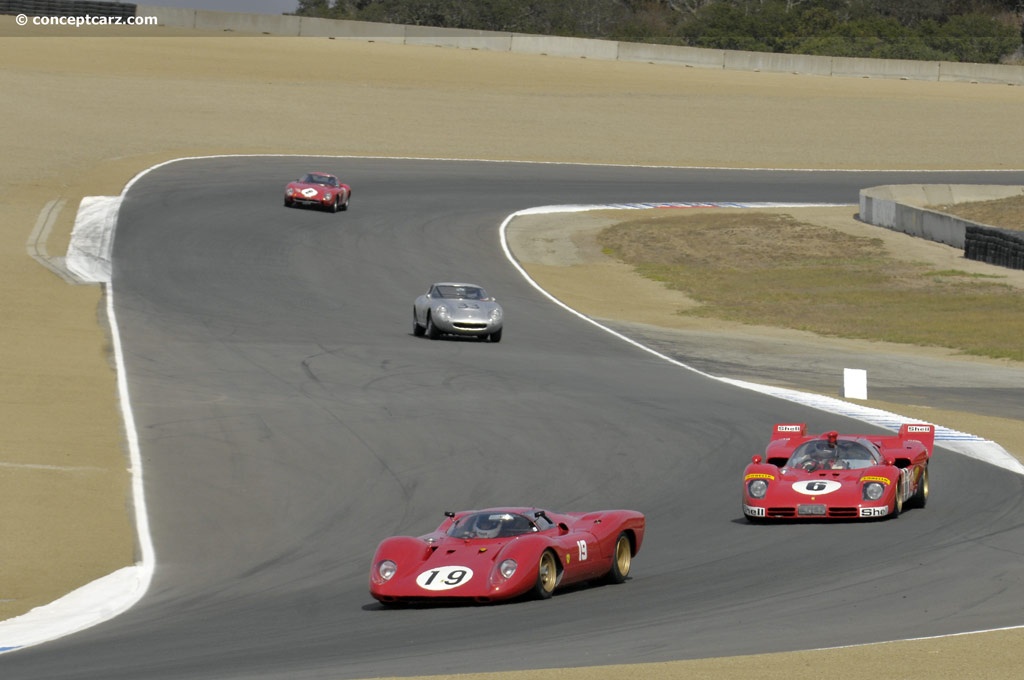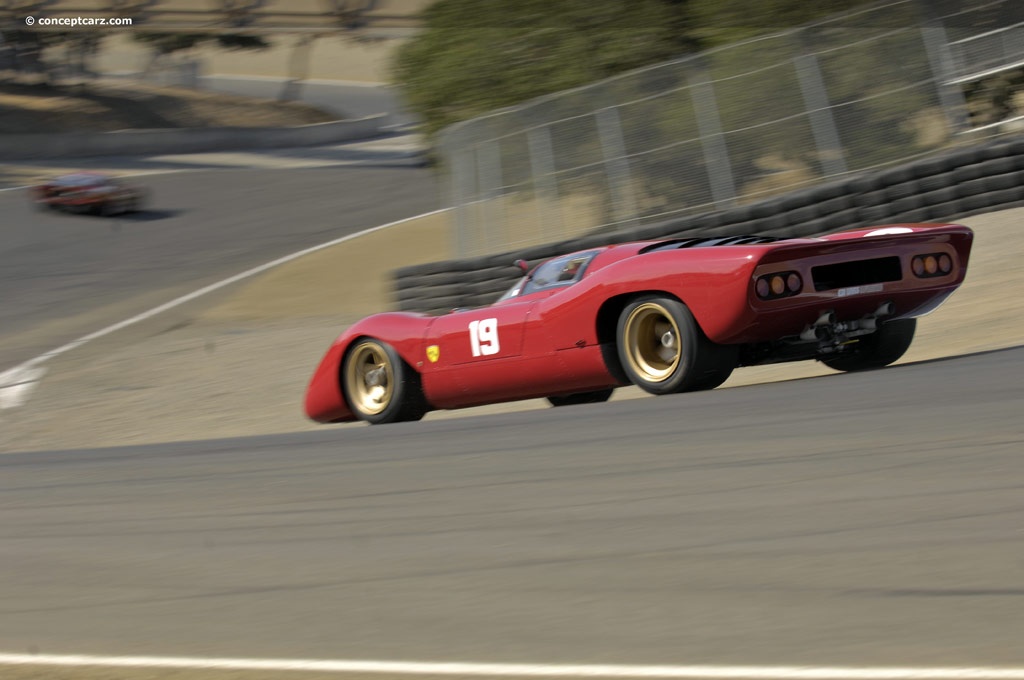The legendary Ferrari marque was formed in the post-War era, near the close of the 1940s. It is remarkable at the immediate success acquired by this very young company in both sales and Grand Prix competition. It was as though the company could do no wrong. Even though they were not always at the fore-front of technology, they still managed to find ways to win. At the heart of their success was a well-designed V12 engine that would carry Ferrari cars for several decades, with gradual improvements being made throughout the years. 
Coupe
Chassis #: 0872
View info and historyDuring the 1950s and 1960s, the Ferrari cars were the ones to beat. Only after the Ford Motor Company made a major assault on dethroning the prancing horse, did Ferrari's dominate career come to a temporary end in Grand Prix competition. For the 1968 season, the Commissione Sportiva Internazionale's (CSI) introduced new rules that crippled the Ferrari team even further, making their cars obsolete. A new car was needed but that would take considerable effort, resources, and funds to continue in Group 6 competition. Enzo Ferrari felt it was too much, so he switched his efforts to Formula 1 and CanAM Competition.The Canadian/American Challenge Cup was introduced in 1966 and there were very few rules or restrictions on what could be done to a vehicle. This allowed engines to be large and powerful, the cars to take every aerodynamic advantage possible, and teams to be clever and creative. For many years, the CanAm cars would be faster than Formula 1 cars.When the Ferrari cars were sidelined after the 1967 season, Luigi Chinetti, the American Ferrari importer, had his North American Racing Team (NART)'s Ferrari 412 P sent to Italy for modifications. Ferrari lengthened the body section, removed the roof, shortened the rear, and streamlined the nose. The engine remained mostly unaltered, though underpowered compared to other competitors. Ferrari hoped that the vehicles low weight and handling would make up for the 'low' 450 horsepower. 
Coupe
Chassis #: 0872
View info and historyThe Ferrari CanAm car was dubbed the 350. It had some success but never a top contender or a top-three finish. At the close of the 1968 season, the Ferrari 612 P was introduced. It was powered by Ferrari's largest engine to-date, a 6.2-liter unit that produced 620 horsepower. The engine was placed mid-ship, mated to a four-speed gearbox, and powered the rear wheels. The car competed at Las Vegas but it failed to finish the first lap due to a multi-car accident. The 612 P was not damaged, but during the incident sand made its way into the engine and was unable to re-start.For the 1969 CanAm Season, the NART team returned with their 612 but with a modified engine. Ferrari had increased the engines output to 640 bhp by increasing the displacement to 6.9-liters, resulting in a new designation, the Ferrari 712 P. It would race only one event. A black-flag given after rule violations did not help Ferrari's attempt at winning the race. With further development, the Ferrari 350/612/712 may have had more success, but a CanAM championship was not what Ferrari wanted. Their efforts were switched back to World Championship competition for 1969, when the CSI regulations were changed, making competition more attractive for Ferrari. The Group 4 homologation requirements were lessened in an effort to lure more teams back to sports car racing. What had, in the prior year, required a minimum of 50 production cars in order to compete was lessened to just 25. Likewise, the rules surrounding Group 6 competition was simplified, hoping to appeal to teams such as Ferrari. The rule changes meant that Ferrari's 612 P chassis fitted with a gearbox and engine from their F1 efforts would qualify for the Group 6 class. Ferrari planned only a mild assault on the 1969 racing season, while concentrating on further design and development of their 312 P and the F1 engine. The fuel-injected engine featured four valves-per-cylinder, twin-cams, and produced 420 horsepower. It was given a five-speed gearbox, mounted in the semi-monocque chassis, and clothed with a Spyder body. 
Coupe
Chassis #: 0872
View info and historyFerrari had intended to compete at the opening round of the Championship Season at Daytona, but the car was damaged during testing and unable to race. The inaugural outing for the 312 P was at the 12 Hours of Sebring where it was piloted by Chris Amon and Mario Andretti. The car qualified on pole and looked very promising. The early stages of the race were met with mechanical problems. The problems were repaired and the car returned to racing. Later in the race, the nose of the 312 P was damaged when it collided with another car. The team attempted to repair the car, but the repairs were inadequate. Though it was able to finish the race, it was crippled by overheating and placed second overall. A second Ferrari 312 P was built and ready for the next Championship race. It qualified on pole but was unable to claim the checkered flag due to mechanical problems. The first 312 P chassis did not race as it had been shipped back to Europe and sent to LeMans for the opening test days. The test sessions revealed that the spider coachwork was unsuitable for the high speed track. Victory would go to the German Porsche team who unveiled their new Group 4 competitor, the 917. At Monza, Ferrari entered both 312 Ps. Both cars did well, especially through the corners. The Achilles heal for the Ferraris on this course was the tires, which wore quickly prompting several pit stops. The newest Ferrari (chassis 0870) retired after the engine was blown. The original 312 P (chassis 0868) retired after a crash. 
Coupe
Chassis #: 0872
View info and historyFerrari chose not to race the sole 312 P at the Targa Florio and to wait for the Spa 1000 km. Victory would go to the Porsche 917 with the 312 P finishing in second. The next race of the season was at the Nurburgring 1000 km. The Ferrari 312 P sat on the grid surrounded by six Porsches. The Ferrari provided some competition for Porsche, but its hopes were snapped part-way through the race when the V12 engine had mechanical issues. Porsche would win both the race and the championship.As the season came to a close, Ferrari had time to repair their cars and prepare for the next championship season. Chassis 0870 was given a new body which was hoped would alleviate problems at LeMans. A third chassis, number 0872, was created as a replacement for chassis 0868, which had crashed at Monza. To keep things simple at LeMans, Ferrari labeled the new chassis as '0868'. The Porsche 908 and 917s returned in proper fashion, as did the Ford GT40s, both doing well during qualifying. During the opening lap of the race, John Woolfe driving a Porsche 917 crashed at Maison Blanche. Woolfe was killed; he had not been wearing his safety belt. During the wreck, the fuel tank became dislodged and landed in front of Chris Amon's Ferrari 312P. Amon, unable to avoid it, ran over the fuel tank causing it to explode under his car. The car was ruined and its hopes at a victory had come to a close. The race was stopped for two hours due to these two incidents.The sole Ferrari 312 P continued the race. It proved to be very agile and quick but its luck soon changed. The car would be side-lined due to mechanical problems and was unable to complete the race. This was the last major attempt to win the championship with the 312 P cars. Porsche and their 917 cars were too fast; a new car was needed. The 312 P's were sold to Luigi Chinetti while Ferrari focused on a new Group 4 car, the 512 S.
by Daniel Vaughan | Oct 2008

Coupe
Chassis #: 0872
View info and history

Coupe
Chassis #: 0872
View info and history

Coupe
Chassis #: 0872
View info and history

Coupe
Chassis #: 0872
View info and history
by Daniel Vaughan | Oct 2008
Similar Vehicles
Similar Automakers
Similarly Sized Vehicles
from 1969
1969 Ferrari 312 P Vehicle Profiles
Recent Vehicle Additions
Related Automotive News

1969 24 Hours of Le Mans: A Traditional Statement Provides a Memorable Race
What if a statement ended up costing one of the biggest victories of ones career Would it be worth it Jacky Ickx would come close to finding out as he approached the checkered flag on the afternoon of the 15th of June in 1969.
Ford had determined...

FIA Manufacturers Championship Flexes its Horsepower at Rolex Monterey Motorsports Reunion
Theres something about the name and sound of Ferraris that stoke nearly everyones imaginations and dreams. These dreams will come alive at the Rolex Monterey Motorsports Reunion as cars from this iconic brand prepare for Monterey August 16-19 at WeatherTech...

Ex-Surtees race-winner and rare Chinetti-commissioned Spider join Salon Privé's Ferrari 75th Anniversary class
Salon Privé Concours dElégance presented by Aviva introduces pair of important Maranello models - from road and track - in its Ferrari 75th Anniversary class
#1 - One of only two Ferrari 275 GTB4 S NART Spiders built with an aluminium body, and...

EX-SCUDERIA FERRARI WORKS ALFA ROMEO TIPO B P3 LEADS EARLY ENTRIES FOR RM SOTHEBY'S PARIS SALE
Historic Alfa Romeo Tipo B P3—the first P3 to be offered for public sale in over a decade, and one of the worlds most important pre-war Grand Prix cars—headlines RM Sothebys 2017 Paris auction, 8 February
Held during the world-famous Rétromobi...

CHUBB INSURANCE CONCOURS D'ELÉGANCE AT SALON PRIVÉ CONFIRMS WORLD-LEADING COLLECTION OF CARS FOR 2015 EVENT
Outstanding line-up of cars will be paraded at new home of Blenheim Palace as Salon Privé celebrates 10th year anniversary
1937 Delahaye known as Star of India set to be one of the stars of the show, as well as Ferrari 250 GT Berlinetta Tour de...
Luigi Musso: Talented, Tempting and Troubled
Following Alberto Ascaris back-to-back titles in 1952 and 1953 there have been no Italian Formula One World Champions. While there has been a great amount of hope throughout the years, Italians have been left without a World Champion. Perhaps, it could...























